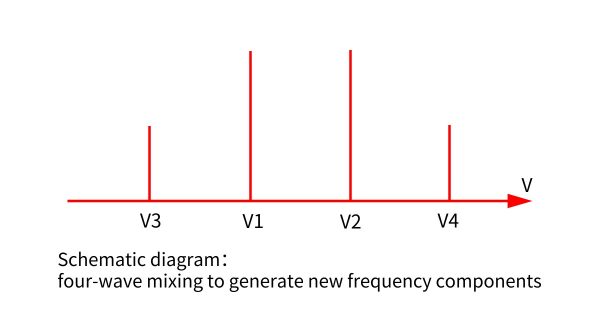What is four-wave mixing
This article mainly introduces four-wave mixing, including its definition, generation and function.
Definition: Interaction of light based on X(3) nonlinear effect
Four-wave mixing is a nonlinear effect based on third-order optical nonlinearity (described by the X(3) coefficient). Four-wave mixing can occur when there are at least two different frequency components of light propagating together in a nonlinear medium such as an optical fiber. Assuming that there are two frequency components v1 and v2 in the input light (v2>v1), due to the existence of the refractive index modulation of the difference frequency, two new frequency components will be generated (as shown in Figure 1): v3=v1-(v2 -v1)=2v1-v2 and v4=v2+(v2-v1)=2v2-v1. At this time, if the v3 or v4 component originally exists, it will appear that v3 or v4 is amplified, that is, the two frequency components have undergone parametric amplification.

When four-wave mixing involves four distinct frequency components, it is non-degenerate four-wave mixing. Of course there is also degenerate four-wave mixing, where the two frequencies in the four-wave mixing coincide. For example, a single-frequency pump can be used as an amplification source for signal light of an adjacent wavelength. In this four-wave mixing process, each time a photon is added to the signal light (that is, to achieve amplification), two two pump wavelength photons, and an idler wave photon on the other side of the pump wavelength.
The four-wave mixing process is very phase-sensitive (ie, four-wave mixing depends on the relative phase of all light involved). When the laser satisfies the phase matching condition in the medium such as optical fiber, the four-wave mixing effect will be effectively enhanced with the increase of the propagation distance. The condition of phase matching means that the frequencies of the components in the four-wave mixing are close together or that the medium has a suitable dispersion curve. When the phases are severely mismatched, the four-wave mixing effect is greatly suppressed. In solid media, phase matching can also be achieved by adjusting the direction and angle between different beams.
Four-wave mixing in optical fibers is closely related to self-phase modulation and cross-phase modulation, both of which are caused by the same nonlinear effect (the Kerr effect), except that the frequency of the light in each effect is different. The degenerate state is different.
Effect
Four-wave mixing works differently in different situations, such as:
- It participates in spectral broadening in some fiber amplifiers (eg, fiber amplifiers with nanosecond pulse widths). In some applications, this spectral broadening effect is so strong that it can even generate supercontinuum. The process of supercontinuum generation involves many different nonlinear effects, and four-wave mixing will play a great role in the generation of long pulse supercontinuum;
- Parametric amplification based on four-wave mixing can be used in optical parametric amplifiers (OPAs) and optical parametric oscillators (OPOs) in optical fibers. In this case ν_1 and ν_2 are overlapping. Compared with the optical parametric amplifiers and optical parametric oscillators based on the χ^((2)) nonlinear effect, the frequency of the pump light in this device based on the four-wave mixing effect is between the signal light and the idler light. of;
- Four-wave mixing is usually harmful in optical fiber communication, especially in wavelength division multiplexing technology, four-wave mixing will cause crosstalk between different channels and unbalance of channel power. This effect can be suppressed by using unequally spaced channels;
- In spectroscopy, four-wave mixing often occurs in coherent anti-Stokes Raman spectroscopy. In this method, two input light waves produce a detected signal with a frequency slightly higher than that of the input light. By varying the time delay of the input beam, excited state lifetimes and dephasing rates can also be measured.
- Four-wave mixing is also used in techniques such as phase conjugation, holographic imaging and optical image processing.
